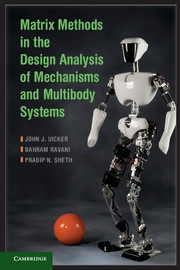Book contents
- Frontmatter
- Contents
- Preface
- About the Authors
- 1 Concepts and Definitions
- 2 Topology and Kinematic Architecture
- 3 Transformation Matrices in Kinematics
- 4 Modeling Mechanisms and Multibody Systems with Transformation Matrices
- 5 Posture Analysis by Kinematic Equations
- 6 Differential Kinematics and Numeric Solution of Posture Equations
- 7 Velocity Analysis
- 8 Acceleration Analysis
- 9 Modeling Dynamic Aspects of Mechanisms and Multibody Systems
- 10 Dynamic Equations of Motion
- 11 Linearized Equations of Motion
- 12 Equilibrium Posture Analysis
- 13 Frequency Response of Mechanisms and Multibody Systems
- 14 Time Response of Mechanisms and Multibody Systems
- 15 Collision Detection
- 16 Impact Analysis
- 17 Constraint Force Analysis
- Index
4 - Modeling Mechanisms and Multibody Systems with Transformation Matrices
Published online by Cambridge University Press: 05 April 2013
- Frontmatter
- Contents
- Preface
- About the Authors
- 1 Concepts and Definitions
- 2 Topology and Kinematic Architecture
- 3 Transformation Matrices in Kinematics
- 4 Modeling Mechanisms and Multibody Systems with Transformation Matrices
- 5 Posture Analysis by Kinematic Equations
- 6 Differential Kinematics and Numeric Solution of Posture Equations
- 7 Velocity Analysis
- 8 Acceleration Analysis
- 9 Modeling Dynamic Aspects of Mechanisms and Multibody Systems
- 10 Dynamic Equations of Motion
- 11 Linearized Equations of Motion
- 12 Equilibrium Posture Analysis
- 13 Frequency Response of Mechanisms and Multibody Systems
- 14 Time Response of Mechanisms and Multibody Systems
- 15 Collision Detection
- 16 Impact Analysis
- 17 Constraint Force Analysis
- Index
Summary
Introduction
A mechanism or a multibody system consists of several bodies or links that move together in a coordinated fashion based on the nature of the connections between them. The individual bodies or links are usually attached through joints such as in robot manipulators, biomechanical systems, mechanisms and machines, or other clever devices such as in aerospace systems. As a system moves, its posture changes, including displacements of the individual bodies while maintaining the connections through the joints.
The classical formulations of kinematics of rigid bodies discussed in Chapter 3 can be adapted to multibody systems. In order to do this, however, we must keep track of all bodies and their interconnections and make sure that their displacements and motions are described in a fashion that allows us to track the posture of the entire mechanism or multibody system. The matrix method presented in this and subsequent chapters provides a systematic method that allows such a development with no ambiguities. When combined with the methods for topological examination of mechanical systems from Chapter 2, the overall approach provides a powerful tool for computer-aided analysis of mechanisms and multibody systems and for development of general-purpose software tools for such applications.
Information
- Type
- Chapter
- Information
- Publisher: Cambridge University PressPrint publication year: 2013
